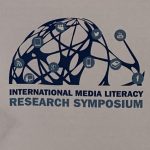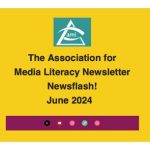A Media Literacy Menu : Ingredients for Successful Media Studies
by Barry Duncan
The following observations are designed to serve as probes and provocations to uncover the essence of some important ideas about media education and media studies. Based largely on the experience of The Association for Media Literacy during the last ten years, I hope these ideas and resources will stimulate discussion and debate. In the media classroom, we want to pursue thoughtful media analysis in which it is understood that class discussions and reflection are the basis for constructing new knowledge. In this context, the classroom is a ‘site of struggle’ in which meanings are negotiated. UK educator Len Masterman insists that media studies should be inquiry-centered, co-investigative, (it does not seek to impose a specific set of values) egalitarian, and dialogic.
1) Teachers need to find a variety of ways of exploiting the ‘teachable media moments.’
When excitement over a media text/event comes our way, go for it ! Here is the most direct and relevant way to contextualize the key concepts of media: how media construct reality; the role played by media
codes and conventions; the nature of audience, the role of media industries; and the pervasive impact of values and ideology. Encourage in-depth study through comparing the extensive media coverage of a major media event. Examples: the death of Diana; the coverage of Clintongate; the events of September 11; the shootings at Columbine; the hyping of the Titanic and the new Star Wars films; the trend of artificially-created band. Use plenty of surveys to find out what students already know about the media.
2) Make media production an integral part of your course.
As UK educator Eddie Dick pointed out, we want to have both “critical practice as well as practical criticism.” Therefore, link your analytical examples with practical work- using camcorders, multimedia digitizing,. Constructing storyboards and sequencing pictures can be done at little cost.
3) Use all the key concepts of media to deconstruct media texts.
While codes, conventions and aesthetics are generally well done, others are often neglected including the following:
- Audience: how each of us makes sense of any media text on the basis of our gender, culture , race, and our individual and collective needs. See (Buckingham,1990) and (Duncan,1996).
- Institutions: focus on concerns about social, cultural and political relations. Sites include: media representation of schools, hospitals, and the military.
- Industry- including critical topics such as ownership and control, the impact of transnational corporations and the global economy; cross media merchandising, e.g. Star Wars. Lest the topic seem too abstract, use documentaries on Coca Cola, McDonald’s, and Nike. Help students investigate monopolies, the extent of corporate resources for advertising and the incredibly powerful role of public relations’ initiatives. Critical marketing has become the most important aspect of modern media. Read Naomi Klein’s invaluable book NoLogo: Taking Aim at the Brand Bullies, Random House, 2000.)
4) Place media literacy in the broader perspectives provided by cultural studies approaches to literature and engaging in fewer literary approaches to popular culture.
5) Be up front about the importance of media pleasures – guilty or otherwise.
But the notion of the personal satisfactions in media consumption and the joys of fandom, from admiring the Backstreet Boys to delving into quirky film noir movies, must be acknowledged; otherwise, the strident protectionist approach to media literacy will dominate. Teachers should begin by acknowledging their own problematic and contradictory passions and be prepared, when appropriate, to share them. Why not encourage students to write thoughtful papers on their media pleasures and encourage them to use their media logs for open – ended responses?
6) Learn from media professionals to see media and popular culture in action and be prepared to expand the territory of the subject.
Scan your community for potential speakers and field trips. Seek out film, television and sound producers, photographers, journalists, advertisers, public relations agencies, and media academics. Visit production houses including those for film, television and multimedia technologies. Look for opportunities to watch the taping of regularly produced shows. Organize a trip to a shopping mall, a theme park, a video arcade or some upscale urban site. Check out book and poster stores including comic book venues. Broaden the concepts of media literacy to include artifacts such as Barbie dolls, action figures and all manner of pop kitsch. By adopting an expanded definition of media studies, the view from the classroom on our communities will be richer and more complex
7) Where feasible, teach through concepts and important themes.
Tackle broad areas such as representation, narrative, audience and media industries rather than being confined to genre- specific
8) Avoid the tendency to depoliticize media texts.
Teach not only ”through’ but also ‘about’ the media. There are too many bland media literacy products in circulation. Without going on a crusade of media bashing fueled by moral panics, the media classroom deserves openness, intellectual rigor, loads of enthusiasm and a willingness to take risks.
9) Encourage oppositional readings of mainstream media.
Use the bounty of material on topics such as the Gulf War and the recent War in Afghanistan, and the tobacco industry PR spin to demonstrate how the dominant media are able to manufacture consent. Encourage mainstream readings of popular television texts, and then model some oppositional readings. Try to encourage students to transfer their insights gathered in the media classroom into other areas: the politics of schooling, the role of authority in the family, the world of work. Otherwise, much of our endeavor will have limited impact. (Guard against playing ‘spot the stereotype’ as an end in itself.)
10) Face the challenges and controversies associated with teaching about media representation.
Representation is generally considered the central principle in all media study, and we must be prepared to mediate its complexity. For example, in studying race and the media there is a danger of essentializing groups or ‘the other,’ of limiting the nature of difference through resorting to stereotyping. Today, the legacy of living in a multicultural society is the recognition that identity is an evolving, hybrid, and unstable concept. This in-between state necessitates finding appropriate discourses. Education critic Henry Giroux reminds us that today, by necessity, we are all border crossers. Welcome to the global village!
11) Insist that students conduct original research when doing media projects.
Using ethnographic models, students can learn to effectively observe, interview, and record the opinions and descriptions of individuals and groups when they are researching the reasons for the popularity of TV programs, rock bands, and celebrities. Making students become avid researchers will ultimately change the social dynamics of the classroom.
12) Use appropriate instruments/rubrics for authentic media assessment.
To give media studies credibility and to overcome the dangers of arbitrary and subjective responses to student work, we need systematic approaches and easy-to follow models. As Kathleen Tyner reminds us, “When subject standards, classroom tasks, and student assessment are aligned, teachers can better recognize when learning takes place. (See also Chris Worsnop, 1999).
13) Explore the richness of the many meaningful alternatives to mainstream media.
Access independent film and experimental art which explores media connections. Look for media books and periodicals offering alternatives to mainstream media coverage.
14) To stay relevant, media education must address comprehensively the new and converging communication technologies, from multimedia and Nintendo to the Internet.
The new media are reconfiguring media language, fostering hybrid identities and multiple literacies, and, as McLuhan noted, obsolescing aspects of communications discourse while retrieving others. Technotopic discourse seems to prevail and Microsoft Inc. continues to dominate the world – all of this should be grist for the media teacher’s mill. Mediate this vast cyber domain through the key concepts of media and see what important insights emerge. Regrettably, there is still a dearth of rigorous analysis supported by solid empirical data from the classroom. (See the work of Marshall McLuhan and Sefton-Green’s anthology, Digital Diversions.)
15) Media teachers need to connect with each other.
Given that our numbers are small and our educational clout often limited, it is of paramount importance to connect with our ‘interpretative community.’ The qualified success of the Association for Media Literacy is largely attributable to our extensive collaboration in creating textbooks, newsletters, writing media expectations and new courses for education authorities and organizing workshops and international conferences such as Summit2000.
Bibliography
- Branston, Gill and Stafford, Roy: The Media Student’s Book. R. Routledge, Second edition, 1999
- Buckingham, David. Watching Media Learning. Falmer Press, September, 1990
- Duncan, Barry et al. Mass Media and Popular Culture. Harcourt-Brace, Toronto, 1996
- Kellner, Douglas. Media Culture; Cultural Studies, Identity and Politics Between the Modern and the Postmodern (Hardcover). Routledge, 1995
- Masterman, Len and Francois Mariet. Media Education in 1990’s Europe. Council of Europe Press
- Morgan, Robert. “Messing with Mr. In-Between: Multiculturalism and Hybridization.” English Quarterly vol. 29, no 1, 1997
- Schiller, Herbert. Culture, Inc.:The Corporate Takeover of Public Expression. Oxford University Press, 2005 reprint
- Sefton-Green, Julian, ed. Digital Diversions: Youth Culture in the Age of Multimedia. UCL Press, 1998
- Tyner, Kathleen. Literacy in a Digital World: Teaching and Learning in the Age of Information. Lawrence Erlbaum Associates, 1998
- Worsnop, Chris. Assessing Media Work: Authentic Assessment in Media Education. Toronto: Wright Communications, 1996


